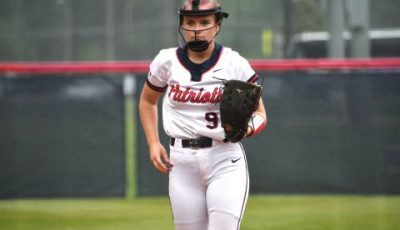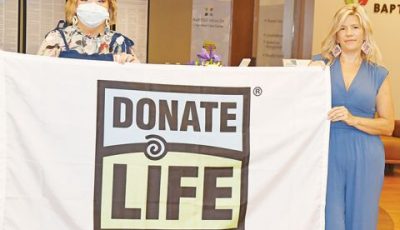Baptist Health Corbin Medical Director Dr. David Worthy answers COVID–19 frequently asked questions
The ongoing COVID–19 pandemic has continued to generate questions and controversy. As a result, The News Journal reached out to Baptist Health Corbin Medical Director Dr. David Worthy to answer a number of the most common questions concerning the state of the virus, testing, when we may see a vaccine, infection and mortality rates, testing protocols, and whether someone may be infected multiple times.
Dr. Worthy said while there have been several reported cases of individuals, who have recovered from COVID–19, contracting the virus a second time, there are multiple variables that make it too soon to determine whether people, in general, may retain the antibodies to immunize against the virus once they have contracted it, or were they victims of faulty testing.
“It is an open-ended question,” Worthy said. “There just hasn’t been enough time and re-exposure to answer for certain.”
Worthy said upon contracting and overcoming COVID–19 some will develop and maintain and high level of antibodies, while others will see their antibody levels wane over time.
Mortality rate
While states are updating their respective COVID–19 related deaths on a daily basis, and there is a corresponding national rate, Worthy said overall, the mortality rate has significantly decrease in the U.S. and across the world.
In the U.S. the mortality rate was at 6 percent. It currently stands at 1.1 percent.
“We are doing well,” Worthy said noting that it is even more impressive compared to other countries. Great Britain’s rate has declined in that time as well, but remains at 15.8 percent compared to 16.2 percent in April.
Mexico’s rate continued to climb from 10.1 percent in April to 13.2 percent in June, before falling to 10 percent in July.
Italy, which was one of the worst hot spots, saw its rate reach 19.5 percent in April before falling to 7.9 percent in July.
Worthy said when the national rate in the U.S. is broken down by state, and it shows a number of hot spots such as Arizona and Florida.
“We are putting a lot less people on ventilators,” Worthy said adding that outside of these hot spots, the supply of hospital facilities and medical equipment is not in danger of being overwhelmed at the moment.
Worthy said the question of taking the pressure off of these hot spots by transferring patients to neighboring places and state with available facilities and equipment is not as simple as it sounds.
“It is very difficult to shift across geography,” Worthy said noting that it involves having the necessary mobile equipment to use during the transport, the vehicles to make the transport while maintaining service in the already overwhelmed area, and the area where the patient is going, and the high cost of such medical transport.
“This happens every year without COVID–19,” Worthy said pointing to an above normal flu season, or other virus.
Testing
Worthy said a number of factors determine the validity of testing results and the associated numbers.
There are several types of tests being used. However, the PCR test that involves inserting a swab up into the nasal cavity is the most accurate as the area where the nose and mouth come together is where the virus really concentrates.
“Even then, you are going to get some false positives,” Worthy said.
“What is far more concerning is a false negative,” he emphasized.
While there is a push to have more people get tested, Worthy said there are a number of factors individuals should consider when determining if and when to be tested.
The first is whether the person is displaying any of the known symptoms of COVID–19, including shortness of breath, loss of sense of smell, cough, or fever.
If symptoms do develop, Worthy said the individual should quarantine immediately and get tested as soon as possible.
Those who have been exposed to someone that has been diagnosed with COVID–19 should be tested.
“Particularly if it has been with your mask off, up close, or someone you live with,” he said
The third group in the testing hierarchy is healthcare workers.
Worthy said one of the biggest hurdles with testing is the turnaround time to get the results. He noted that he recently spoke with his father-in-law in Philadelphia, who was tested two weeks ago and still hasn’t received the results.
“Random testing that they can’t get the results back quickly is a complete waste of time,” Worthy said, noting the results need to be available within 36 to 48 hours.
“Some of the airlines are requiring a negative test result for passengers to be able to fly,” Worthy added again emphasizing the key is to have a quick turnaround.
Second wave
Worthy said based on the curves, a number of places are showing all indications of a second spike in COVID–19.
While the hot spots are likely to continue, Worthy said that efforts to curb the spread of the virus through the use of masks, washing hands, and social distancing will likely avoid a nationwide spike.
Virus skeptics
To those who doubt the existence of COVID–19, Worthy said it absolutely exists, but the magnitude of the effect is subject to debate.
“It has never been seen on the planet before,” Worthy said.
“There were all kinds of predictions on how high the death rate would be,” Worthy added. “So, where the confusion comes in is that we shut down the economy to not overwhelm the healthcare system.”
Worthy noted that, in general, the healthcare system has been able to weather the virus. However, as he previously noted, the hotspots have resulted in local medical facilities being overwhelmed.
“The good news is the virus is less lethal than first expected,” Worthy said.
Worthy said of those who do contract COVID–19, 50 percent are going to be asymptomatic, while 30 percent will experience only minor symptoms. Another 20 percent will have more severe symptoms.
“We are starting to get the handle on it,” Worthy said.
“My only fear if we have a bad flu season, along with a 10 percent spike in COVID–19, we could be back in trouble,” he said.
Masks and social distancing
It is not uncommon around the area to find individuals who refuse to adhere to the state and business mandates concerning the wearing of masks and social distancing.
Worthy noted that he was recently visiting family in New Jersey. While going out in the public there, it was unheard of to see someone not wearing a mask or social distancing.
COVID–19 takes between two and 14 days to incubate. If the general public were to more strictly adhere to the mandates, and wash their hands/use sanitizer as recommended, Worthy said within two to three weeks, the infection rate would dramatically decrease.
“It would eliminate transmission,” Worthy said.
In addition, Worthy said while those who are young and relatively healthy are more likely to be asymptomatic, wearing the mask is for those around them.
“They are likely to take someone else out, so it about protecting others,” Worthy said.
Vaccine
Worthy said a timeline on when a vaccine may be generally available is hard to lay out as there are a number of factors involved.
While there are two that are currently in the later phases of trials, meaning they are undergoing testing on bigger populations, there are other factors besides whether they are effective.
The testing must show whether the virus causes any harm, and how it works when the test subjects are exposed back to the virus.
“That takes time,” Worthy said of having those individuals significantly exposed to make a determination.
Worthy noted that the vaccination process may include two doses a month apart.
“It can take months and months. Then, after final approval, you have to scale production and have a distribution system for hundreds of millions of people,” Worthy said.
“If we are lucky, maybe in the spring we will know about it,” he said.







